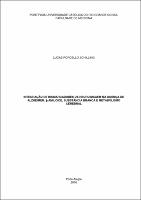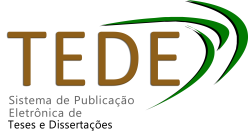| Share record |


|
Please use this identifier to cite or link to this item:
https://tede2.pucrs.br/tede2/handle/tede/7432| Document type: | Tese |
| Title: | Interação de biomarcadores de neuroimagem na Doença de Alzheimer : β-amiloide, substância branca e metabolismo cerebral |
| Author: | Schilling, Lucas Porcello  |
| Advisor: | Palmini, André Luis Fernandes |
| First advisor-co: | Rosa Neto, Pedro |
| Second Advisor-co: | Rieder, Carlos Roberto de Mello |
| Abstract (native): | A fisiopatologia da Doença de Alzheimer (DA) envolve diversos mecanismos patológicos, como acúmulo de β-amiloide e de emaranhados neurofibrilares, alterações na substância branca e neurodegeneração. Este trabalho consiste em um estudo transversal, cujo objetivo foi investigar os efeitos da integridade da substância branca e do depósito de β-amiloide como fatores determinantes do hipometabolismo cerebral no continuum da Doença de Alzheimer (DA). Utilizando dados obtidos através do consórcio internacional Alzheimer’s Disease Neuroimaging Initiative (ADNI), foram avaliados 96 indivíduos (27 sujeitos cognitivamente normais - CN, 49 sujeitos com comprometimento cognitivo leve – CCL, e 20 pacientes com DA) que realizaram um protocolo completo de neuroimagem com tomografia por emissão de pósitrons (PET) com [18F]Fluordeoxiglicose ([18F]FDG) e [18F]Florbetapir e ressonância magnética nuclear (RMN) com a sequência de imagem de tensor de difusão (DTI). Na primeira parte do estudo, no grupo DA foram identificadas áreas de redução da anisotropia fracionada (FA) no fascículo angular e fórnix. Dentre essas regiões, um voxel de interesse (VOI) foi bilateralmente selecionado no fascículo angular para as análises subsequentes. Após, examinamos a associação entre a FA no fascículo angular bilateral, o depósito de β-amiloide através do PET [18F]Florbetapir Standardized Uptake Value Ratio (SUVR) nas regiões de interesse e a possível associação da interação entre ambos no hipometabolismo cerebral avaliado através de PET [18F]FDG. No grupo DA, a magnitude do hipometabolismo cerebral no corpo estriado, córtex orbito-frontal, temporal basal e mesial, pré-cúneo e cíngulo anterior e posterior foi determinada pelo efeito sinérgico (interação) entre a densidade de agregados de β-amiloide e o grau de desintegracão do fascículo angular, obtidos via [18F]Florbetapir e FA, respectivamente. Não foram identificados clusters estatisticamente significativos nos grupos CN e CCL. Estes resultados apóiam o conceito de que o efeito sinérgico, mais do que os efeitos independentes da amiloidose e da desintegração da substância branca, determina o hipometabolismo regional na DA. De fato, o efeito da interação em nosso modelo, envolvendo o depósito de β-amiloide e a desconexão da substância branca, contribui para um conceito integrativo da fisiopatologia da DA, em que a ação combinada de diferentes processos patológicos potencializa a degeneracão do cérebro. |
| Abstract (english): | The pathophysiology of Alzheimer’s disease (AD) involves several pathological mechanisms, including amyloid-β and neurofibrillary tangles deposition, white matter changes and neurodegeneration. In this tranversal study, we investigated the interaction between white matter (WM) integrity and amyloid-β deposition as a potential determinant of cerebral hypometabolism in the Alzheimer’s disease (AD) continuum. Using the Alzheimer’s Disease Neuroimaging Initiative (ADNI) database, ninety-six subjects (cognitively normal (CN), n = 27; mild cognitive impairment (MCI), n = 49; and AD, n = 20) had positron emission tomography (PET) with [18F]Fluorodeoxyglucose ([18F]FDG) and [18F]Florbetapir, and magnetic resonance imaging (MRI) with Diffusion Tensor Imaging (DTI). In the first part of the study, we identified areas of fractional anisotropy (FA) reduction in angular bundle and fornix in the AD group. Among these regions, we selected for subsequent analyses a voxel of interest (VOI) in the angular bundle bilaterally. Then, using a voxel-based interaction model we examined the association of FA in the angular bundle, amyloid-β deposition, and also the potential interaction of these variables with [18F]FDG cerebral hypometabolism. In the AD group, [18F]FDG hypometabolism in the striatum, basal and mesial temporal, orbitofrontal, precuneus, anterior and posterior cingulate cortices was associated with the interaction between increase in [18F]Florbetapir standardized uptake value ratio (SUVR) in regions of interest and reduction in angular bundle FA. No significant clusters were identified in CN and MCI subjects. The interaction model, including amyloid-β deposition and WM disconnection, supports the concept of an integrative framework of AD pathophysiology where the combination of distinct pathological processes leads to progressive brain dysfunction in important cognitive-related areas |
| Keywords: | Doença de Alzheimer Biomarcadores Tomografia por Emissão de Pósitrons Imagem de Tensor de Difusão Interação Substância Branca Hipometabolismo Demência |
| CNPQ Knowledge Areas: | CIENCIAS DA SAUDE::MEDICINA |
| Language: | por |
| Country: | Brasil |
| Publisher: | Pontifícia Universidade Católica do Rio Grande do Sul |
| Institution Acronym: | PUCRS |
| Department: | Escola de Medicina |
| Program: | Programa de Pós-Graduação em Medicina e Ciências da Saúde |
| Access type: | Acesso Aberto |
| Fulltext access restriction: | Trabalho não apresenta restrição para publicação |
| URI: | http://tede2.pucrs.br/tede2/handle/tede/7432 |
| Issue Date: | 16-Dec-2016 |
| Appears in Collections: | Programa de Pós-Graduação em Medicina e Ciências da Saúde |
Files in This Item:
| File | Description | Size | Format | |
|---|---|---|---|---|
| TES_LUCAS_PORCELLO_SCHILLING_PARCIAL.pdf | Texto Parcial | 7.32 MB | Adobe PDF |  Download/Open Preview |
Items in DSpace are protected by copyright, with all rights reserved, unless otherwise indicated.




